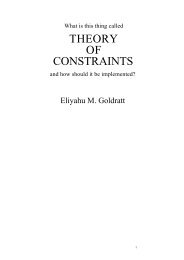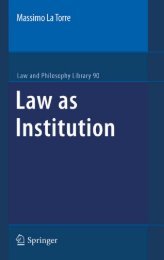Making of a German Constitution : a Slow Revolution
Making of a German Constitution : a Slow Revolution
Making of a German Constitution : a Slow Revolution
You also want an ePaper? Increase the reach of your titles
YUMPU automatically turns print PDFs into web optimized ePapers that Google loves.
Undermining Absolutism • 149In the post-1850 era and after procedural reform, commercial law was the nextmajor target <strong>of</strong> constitutional transformationists. Again, however, the demand forcommercial law reform was heard in years following the Freiheitskriege. JohannZiegler published a treatise on free trade, Ueber Gewerbefreiheit und deren Folgenas early as 1819, and the demand for reform was also evident in Johann Leuch’s VollständigesHandelsrecht (1822). 120 The treatise, Durch welche Bedingungen ist dasSystem der Handelsfreiheit ausführbar? (1834) had to be published anonymouslyduring the censorship crackdown following the Six Acts and Ten Articles <strong>of</strong> 1832. 121Johann H<strong>of</strong>fmann’s Die Befugniss zum Gewerbbetriebe zur Berichtigung der Urtheileüber Gewerbefreiheit und Gewerbezwang appeared in 1841. 122 Gewerbefreiheitfür Nürnberg was published anonymously in 1846, the year <strong>of</strong> the first <strong>German</strong>istentag.123 The pressure was kept on into the 1860s, when Hermann Rentzsch publishedhis Die Gewerbefreiheit und Freizügigkeit in 1861. 124Behind the demand for commercial law reform was the steady production <strong>of</strong>legal history and, thus, the recovery <strong>of</strong> data for a system. The most important figurehere, before Levin Goldschmidt, was Heinrich Thöl, who published the first comprehensivestudy, Das Handelsrecht, in three volumes from 1841. 125 Following Thölmany studies were produced on local arrangements and legal developments. CarlKleinschrod wrote on Bavaria in 1840. 126 Nürmberger published two studies in 1846,Sammlung einiger nürnbergische Handelsrechts-Gewohnheiten and Sammlung vonBeiträgen und andern Anmerkungen zur praktischen Erläuterung der NürnbergerHandelsgerichtsordnung. 127 In 1852, Carl Billich <strong>of</strong>fered a study <strong>of</strong> Württembergand, in 1856, Ferdinand Fischer’s Preußens kaufmännisches Recht was published. 128Two studies were published on proposed legislation for Saxony in 1857 and 1859. 129In 1856, the influential <strong>German</strong>ist Wilhelm Kraut updated Mittermaier’s old findingsin his general system and published his Grundriss zu Vorlesungen über dasDeutsche Privatrecht mit Einschluss des Lehns- und Handelsrechts nebst beigefügtenQuellen. 130It was, however, ultimately, Thöl’s work that influenced the Nürnberg Draft.This draft measure was the source <strong>of</strong> the Gemeines Handelsgesetzbuch <strong>of</strong> 1861. Itwas enacted by various states between 1862 and 1863. After unification in 1871,it was reenacted for the whole Reich and remained the basis <strong>of</strong> commercial lawuntil it was replaced by a new commercial code in 1897. In this regard, the Thöl-Goldschmidt debate was another legendary legal dispute in the <strong>German</strong> legal world.This will not be examined here, because, again, commercial law reform is not themajor focus <strong>of</strong> this study. Nevertheless, Goldschmidt, who was Jewish, was far morewedded to <strong>German</strong> nationalism and the <strong>German</strong>ists than Thöl had been. Indeed,Goldschmidt founded the Zeitschrift für das Gesamte Handelsrecht for this reasonin 1858. 131 Goldschmidt, as his writings from the late 1850s show, was a critic <strong>of</strong>the proposed commercial code <strong>of</strong> 1861. 132 His major works reflected the demandthat any system <strong>of</strong> law be derived from <strong>German</strong> customary arrangements. In thisregard, his Das Handbuch des Handelsrechts (1864) and System des Handelsrechts




